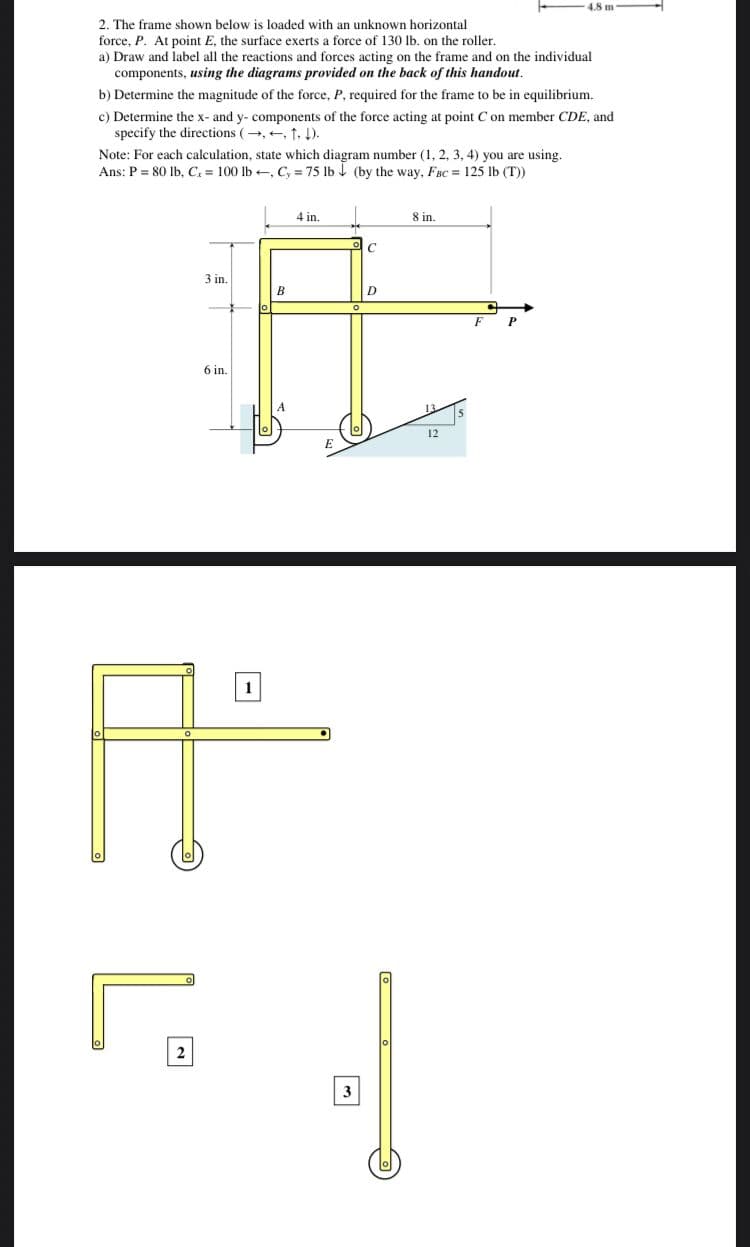2. The frame shown below is loaded with an unknown horizontal force, P. At point E, the surface exerts a force of 130 lb. on the roller. a) Draw and label all the reactions and forces acting on the frame and on the individual components, using the diagrams provided on the back of this handout. b) Determine the magnitude of the force, P, required for the frame to be in equilibrium. c) Determine the x- and y- components of the force acting at point C on member CDE, and specify the directions (,, t. ). Note: For each calculation, state which diagram number (1, 2, 3, 4) you are using. Ans: P = 80 lb, C. = 100 lb, C, 75 lb (by the way, Fac= 125 Ib (T)) 4 in. 8 in. 3 in. D. F 6 in. 12 E
2. The frame shown below is loaded with an unknown horizontal force, P. At point E, the surface exerts a force of 130 lb. on the roller. a) Draw and label all the reactions and forces acting on the frame and on the individual components, using the diagrams provided on the back of this handout. b) Determine the magnitude of the force, P, required for the frame to be in equilibrium. c) Determine the x- and y- components of the force acting at point C on member CDE, and specify the directions (,, t. ). Note: For each calculation, state which diagram number (1, 2, 3, 4) you are using. Ans: P = 80 lb, C. = 100 lb, C, 75 lb (by the way, Fac= 125 Ib (T)) 4 in. 8 in. 3 in. D. F 6 in. 12 E
Elements Of Electromagnetics
7th Edition
ISBN:9780190698614
Author:Sadiku, Matthew N. O.
Publisher:Sadiku, Matthew N. O.
ChapterMA: Math Assessment
Section: Chapter Questions
Problem 1.1MA
Related questions
Question

Transcribed Image Text:4.8 m
2. The frame shown below is loaded with an unknown horizontal
force, P. At point E, the surface exerts a force of 130 lb. on the roller.
a) Draw and label all the reactions and forces acting on the frame and on the individual
components, using the diagrams provided on the back of this handout.
b) Determine the magnitude of the force, P, required for the frame to be in equilibrium.
c) Determine the x- and y- components of the force acting at point C on member CDE, and
specify the directions (→, +, t. 1).
Note: For each calculation, state which diagram number (1, 2, 3, 4) you are using.
Ans: P = 80 lb, C = 100 lb , C, = 75 lb 1 (by the way, FBC = 125 lb (T))
4 in.
8 in.
C
3 in.
В
6 in.
1
3
Expert Solution
This question has been solved!
Explore an expertly crafted, step-by-step solution for a thorough understanding of key concepts.
This is a popular solution!
Trending now
This is a popular solution!
Step by step
Solved in 2 steps with 3 images

Knowledge Booster
Learn more about
Need a deep-dive on the concept behind this application? Look no further. Learn more about this topic, mechanical-engineering and related others by exploring similar questions and additional content below.Recommended textbooks for you

Elements Of Electromagnetics
Mechanical Engineering
ISBN:
9780190698614
Author:
Sadiku, Matthew N. O.
Publisher:
Oxford University Press

Mechanics of Materials (10th Edition)
Mechanical Engineering
ISBN:
9780134319650
Author:
Russell C. Hibbeler
Publisher:
PEARSON

Thermodynamics: An Engineering Approach
Mechanical Engineering
ISBN:
9781259822674
Author:
Yunus A. Cengel Dr., Michael A. Boles
Publisher:
McGraw-Hill Education

Elements Of Electromagnetics
Mechanical Engineering
ISBN:
9780190698614
Author:
Sadiku, Matthew N. O.
Publisher:
Oxford University Press

Mechanics of Materials (10th Edition)
Mechanical Engineering
ISBN:
9780134319650
Author:
Russell C. Hibbeler
Publisher:
PEARSON

Thermodynamics: An Engineering Approach
Mechanical Engineering
ISBN:
9781259822674
Author:
Yunus A. Cengel Dr., Michael A. Boles
Publisher:
McGraw-Hill Education

Control Systems Engineering
Mechanical Engineering
ISBN:
9781118170519
Author:
Norman S. Nise
Publisher:
WILEY

Mechanics of Materials (MindTap Course List)
Mechanical Engineering
ISBN:
9781337093347
Author:
Barry J. Goodno, James M. Gere
Publisher:
Cengage Learning

Engineering Mechanics: Statics
Mechanical Engineering
ISBN:
9781118807330
Author:
James L. Meriam, L. G. Kraige, J. N. Bolton
Publisher:
WILEY